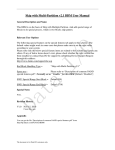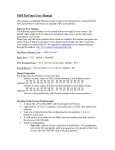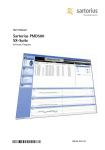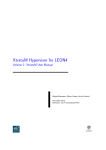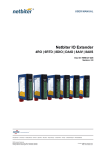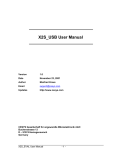Download Harman Multiple Partition V2.1 User Manual
Transcript
Harman Multiple Partition V2.1 User Manual General Description and Name This BBM is for the system that has several partitions. Please note the padding blocks (which don’t need to be programmed) in each partition or not belong to any partitions should be stuffed with all 0xFF in data file. Only the partition table specified blocks of each partition will be programmed (which means all other blocks will not be programmed). This BBM also needs to be calculated ECC. The ECC code is identical to linux kernel BCH; Correct up 8bits error per 512bytes for IPL (block#0~block#3). Correct up 4bits error per 512bytes for IFS and BIOS (other blocks). Relevant User Options The following special features on the special features tab apply to this scheme. The default values might work in some cases but please make sure to set the right value according to your system. Please note only the below special feature items are related to this scheme and ignore any others. If any of below items doesn’t exist, please check whether the right version has been installed or contact Data I/O for support by submitting Device Support Request through this address: http://www.dataio.com/support/dsr.asp Bad Block Handling Type = “Harman Multiple Partition V2.1” PartitionTable File : Point to a .mbn file which describes the partition information. It can be set in any address and any name. Default: “C:\PartitionTable.mbn”. Spare area : “ECC” or “Enabled” Normally select “ECC” to let DAIO calculate ECC. Only if input image file includes ECC, then select “Enabled”. IPL Block Numbers : “4” The number of blocks for IPL. Default is “4”. Handle Empty Page : “NO” Whether add sequence number and ecc to empty pages (all 0xFF). Normally set as “NO”. Default is “YES”. IFS sub-partition signature : “hbcifs” The signature for boot_secondary.ifs, boot_tertiary.ifs and boot_last.ifs in IFS partitions (upto 8 character). Default is “hbcifs”. 9/11/2013 2:10 PM 1 of 3 Special Notes: Format of PartitionTable.mbn: For example: For partition 0 to partition 3, each partition only programs 1 block. Partition 4 starts from block 4, ends at block 259 and programs 48 blocks. Partition 5 starts from block 260, ends at block 515 and programs 48 blocks. Partition 6 starts from block 516, ends at block 771 and programs 48 blocks. Partition 7 starts from block 772, ends at the last block, and programs 48 blocks. If just skip bad block and program the date to the next good block, Set PartitionTable.mbn as follow: 00000000 Start Adr 00000000 01000000 02000000 03000000 04000000 04010000 04020000 04030000 FFFFFFFF FFFFFFFF FFFFFFFF FFFFFFFF FFFFFFFF FFFFFFFF FFFFFFFF 00000001 NAND Flash Block End Adr 00000000 01000000 02000000 03000000 03010000 03020000 03030000 FF070000 FFFFFFFF FFFFFFFF FFFFFFFF FFFFFFFF FFFFFFFF FFFFFFFF FFFFFFFF 00000002 00000003 Actual Data Length 01000000 01000000 01000000 01000000 30000000 30000000 30000000 30000000 FFFFFFFF FFFFFFFF FFFFFFFF FFFFFFFF FFFFFFFF FFFFFFFF FFFFFFFF Attribute FFFFFFFF FFFFFFFF FFFFFFFF FFFFFFFF FFFFFFFF FFFFFFFF FFFFFFFF FFFFFFFF FFFFFFFF FFFFFFFF FFFFFFFF FFFFFFFF FFFFFFFF FFFFFFFF FFFFFFFF For example: Partition 4 starts from block 4, ends at block 259 and programs 48 blocks. The 47th (based on 0) programmed block in this partition should not be all blank. If it is all blank, actual data length can be set to 47, not 48. Revision History V1.0 JUN 28th ,2013 Create this spec. V1.1 AUG 27th ,2013 Add “IFS sub-partition signature”. Appendix 9/11/2013 2:10 PM 2 of 3 You can get the file “Description of common NAND special features.pdf” from http://ftp.dataio.com/FCNotes/BBM/ 9/11/2013 2:10 PM 3 of 3



